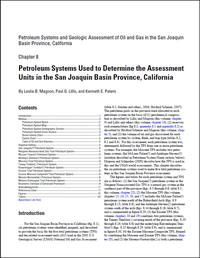For the San Joaquin Basin Province in California (fig. 8.1), six petroleum systems were identified, mapped, and described to provide the basis for the five total petroleum systems (TPS) and ten related assessment units (AU) used in the 2003 U.S. Geological Survey (USGS) National Oil and Gas Assessment (table 8.1; Gautier and others, 2004; Hosford Scheirer, 2007). The petroleum pools in the province were allocated to each petroleum system on the basis of (1) geochemical composition as described by Lillis and Magoon (this volume, chapter 9) and Lillis and others (this volume, chapter 10), (2) reservoir rock nomenclature (fig 8.2; appendix 8.1 and appendix 8.2) as described by Hosford Scheirer and Magoon (this volume, chapter 5), and (3) the volume of oil and gas discovered for each petroleum system by system, flank, and trap type (tables 8.2, 8.3 and 8.4). For this assessment, each petroleum system was determined, followed by the TPS from one or more petroleum systems. For example, the Miocene TPS includes two petroleum systems, the McLure-Tulare(!) and Antelope-Stevens(!) (notation described in Petroleum System Name section, below). Magoon and Schmoker (2000) describe how the TPS is used in this and the USGS world assessments. This chapter describes the six petroleum systems used to make five total petroleum systems in this San Joaquin Basin Province assessment.
The figures and tables for each petroleum system and TPS are as follows: (1) the San Joaquin(?) petroleum system or the Neogene Nonassociated Gas TPS is a natural gas system in the southeast part of the province (figs. 8.3 through 8.8; table 8.5; this volume, chapter 22); (2) the Miocene TPS (this volume, chapters 13, 14, 15, 16, and 17) includes the McLure-Tulare(!) petroleum system north of the Bakersfield Arch (figs. 8.9 through 8.13; table 8.6), and the Antelope-Stevens(!) petroleum system south of the arch (figs. 8.14 through 8.18; table 8.7), and is summarized in figure 8.19; (3) the Eocene TPS (this volume, chapters 18 and 19) combines two petroleum systems, the Tumey-Temblor(.) covering much of the province (figs. 8.20 through 8.24; table 8.8) and the underlying Kreyenhagen-Temblor(!) (figs. 8.25 through 8.29: table 8.9), and is summarized in figure 8.30; (4) the Eocene-Miocene Composite TPS, formed by combining the Miocene and Eocene TPS (this volume, chapter 20); and (5) the Moreno-Nortonville(.) is both a petroleum system and a TPS consisting mainly of natural gas in the northern part of the province (figs. 8.31 through 8.36: table 8.10; this volume, chapter 21). Oil samples with geochemistry from surface seeps and wells used to map these petroleum systems are listed in table 8.11. Finally, the volume of oil and gas expelled by each pod of active source rock was calculated and compared with the discovered hydrocarbons in each petroleum system (figs. 8.37 through 8.39; tables 8.12 and 8.13).


